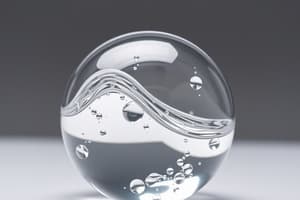Podcast
Questions and Answers
What differentiates isotopes of the same chemical element?
What differentiates isotopes of the same chemical element?
- Number of neutrons (correct)
- Chemical properties
- Number of protons
- Number of electrons
Which law states that the total mass remains constant in a closed system?
Which law states that the total mass remains constant in a closed system?
- Law of Constant Composition
- Law of Multiple Proportions
- Dalton's Atomic Theory
- Law of Conservation of Mass (correct)
According to Dalton's Atomic Theory, how do atoms of different elements compare?
According to Dalton's Atomic Theory, how do atoms of different elements compare?
- They are made of the same particles.
- They have different chemical properties. (correct)
- They combine in any ratio.
- They are identical to one another.
What characterizes a polyatomic ion?
What characterizes a polyatomic ion?
Which of the following elements is categorized as a diatomic ion?
Which of the following elements is categorized as a diatomic ion?
Which experiment was conducted by Ernest Rutherford?
Which experiment was conducted by Ernest Rutherford?
What does the Law of Constant Composition state about chemical compounds?
What does the Law of Constant Composition state about chemical compounds?
How are metal ions typically represented?
How are metal ions typically represented?
Which statement is true about gases?
Which statement is true about gases?
What defines an intensive property?
What defines an intensive property?
What characterizes a compound?
What characterizes a compound?
Which of the following is an example of a physical property?
Which of the following is an example of a physical property?
Which type of mixture has components that are evenly distributed?
Which type of mixture has components that are evenly distributed?
What is true about Bose-Einstein condensate?
What is true about Bose-Einstein condensate?
What best describes a pure substance?
What best describes a pure substance?
Which of the following properties is NOT a characteristic of liquids?
Which of the following properties is NOT a characteristic of liquids?
Which of the following best defines a homogeneous mixture?
Which of the following best defines a homogeneous mixture?
What is the role of the solute in a solution?
What is the role of the solute in a solution?
Which method is best suited for separating nonmagnetic solids from magnetic components?
Which method is best suited for separating nonmagnetic solids from magnetic components?
What component is typically removed when using evaporation to separate a mixture?
What component is typically removed when using evaporation to separate a mixture?
Which of the following correctly describes ions?
Which of the following correctly describes ions?
What type of mixture is blood plasma considered to be?
What type of mixture is blood plasma considered to be?
What does filtration specifically separate in a mixture?
What does filtration specifically separate in a mixture?
Which of the following best defines a molecule?
Which of the following best defines a molecule?
What is the correct name for the Fe2+ ion using the Stock Method?
What is the correct name for the Fe2+ ion using the Stock Method?
Which suffix is used for nonmetal monatomic ions?
Which suffix is used for nonmetal monatomic ions?
Which of the following describes a ternary polyatomic ion?
Which of the following describes a ternary polyatomic ion?
What is the name for HCl when dissolved in water?
What is the name for HCl when dissolved in water?
Which of these compounds is described as being hydrated?
Which of these compounds is described as being hydrated?
What is the correct name for the polyatomic ion ClO3-?
What is the correct name for the polyatomic ion ClO3-?
How do you name a transition metal ion with a higher charge according to the classical method?
How do you name a transition metal ion with a higher charge according to the classical method?
Which of the following is an example of a nonmetal polyatomic ion with fewer oxygen atoms?
Which of the following is an example of a nonmetal polyatomic ion with fewer oxygen atoms?
Flashcards are hidden until you start studying
Study Notes
States of Matter
- Solid: Definite shape and volume, tightly packed particles in a regular pattern.
- Liquid: Definite volume but no fixed shape, particles can move and are close together.
- Gas: No definite volume or shape, widely separated particles.
- Plasma: No definite volume or shape, widely separated charged particles.
- Bose-Einstein Condensate: Formed when a gas of bosons at low density is cooled to near absolute zero.
Phases Changes
- Melting: Solid to liquid.
- Freezing: Liquid to solid.
- Vaporization: Liquid to gas.
- Condensation: Gas to liquid.
- Sublimation: Solid to gas.
- Deposition: Gas to solid.
Properties of Matter
- Physical Properties: Observable or measurable characteristics of a substance. (e.g., melting ice, changing color, boiling water)
- Intensive Properties: Independent of the quantity of matter. (e.g., density, viscosity, melting point, boiling point)
- Extensive Properties: Dependent on the quantity of matter. (e.g., length, width, height, weight)
- Chemical Properties: Ability of a substance to change into a new substance. (e.g., rusting, burning, decomposition)
Classifications of Matter
- Pure Substance: Unchanging composition, includes elements and compounds.
- Elements: Simplest type of matter, composed of one kind of atom. (e.g., carbon, oxygen)
- Compounds: Two or more elements chemically combined in definite proportions. (e.g., carbon monoxide, water)
- Mixture: Different pure substances physically combined in variable proportions.
- Heterogeneous Mixture: Components are not evenly distributed. (e.g., ice in soda, cereal in milk)
- Homogeneous Mixture: Uniform appearance, properties, and composition throughout. (e.g., perfume, blood plasma)
- Solution: Homogeneous mixture of substances with varying proportions. (e.g., water and salt)
- Solute: Substance that gets dissolved.
- Solvent: Substance present in larger quantities than the solute.
Methods of Separating Mixtures
- Magnets: Removing magnetic solids from nonmagnetic components.
- Decantation: Separating liquid from heavy, insoluble solids.
- Evaporation: Heating a solution to evaporate the liquid, leaving behind the solid.
- Sublimation: Separating volatile solids from nonvolatile substances by heating.
- Filtration: Separating solid from liquid using a filter.
- Distillation: Separating miscible liquids with different boiling points.
- Chromatography: Separating components with different solubilities using a mobile and stationary fluid.
Atoms, Ions, and Molecules
- Atom: Fundamental building block of matter, the smallest indivisible unit of an element retaining its chemical properties. (e.g., hydrogen, oxygen, helium)
- Ion: Electrically charged particle formed when atoms or molecules gain or lose electrons. (e.g., chloride ion, magnesium ion)
- Molecule: Group of two or more atoms chemically bonded together forming a stable, neutral entity. (e.g., hydrogen peroxide, ammonia)
- Isotopes: Atoms of the same element with the same number of protons but different numbers of neutrons. (e.g., Carbon-14, Hydrogen-2)
Fundamental Laws of Chemistry
- Law of Conservation of Mass: Total mass of substances remains constant in a closed system, regardless of changes.
- Law of Constant Composition: A chemical compound always contains the same elements in fixed proportions by mass.
- Law of Multiple Proportions: When two elements form more than one compound, the masses of one element that combine with a fixed mass of the other element are in a simple ratio.
Dalton's Atomic Theory
- Matter is made up of tiny, indivisible particles called atoms.
- Atoms of the same element are identical, but different from other elements.
- Compounds form when atoms of different elements combine in whole number ratios.
- Atoms rearrange during chemical reactions to form new compounds.
Timeline:
- Discovery of electron (J.J. Thompson, 1897)
- Oil drop experiment (Robert Milikan, 1909-1917)
- Gold foil experiment (Ernest Rutherford, 1911)
- Energy levels in atoms (Niels Bohr, 1913)
- Discovery of atomic number (Henry Moseley, 1913-1914)
- Discovery of neutron (James Chadwick, 1932)
Naming Ionic Compounds
- Monatomic Ions: Ions consisting of one atom. (e.g., sodium ion, chloride ion)
- Diatomic Ions: Ions consisting of two atoms. (e.g., oxygen, nitrogen, fluorine, chlorine, bromine, iodine)
- Polyatomic Ions: Ions composed of two or more atoms with a charge. (e.g., sulfate ion, phosphate ion)
Naming Rules for Ionic Compounds
- Metal ions: Named as the element. (e.g., Na+ → sodium)
- Transition Metals:
- Classical Method: Lower charge ends in "-ous"; Higher charge ends in "-ic". (e.g., Fe2+ → ferrous, Fe3+ → ferric)
- Stock Method: Roman numerals indicate the charge in parenthesis. (e.g., Fe2+ → iron (II), Fe3+ → iron (III))
- Non-metal ions: Suffix "-ide" added to the element name for monatomic ions. (e.g, Br → bromide, S → sulfide)
- Non-metal Polyatomic Anions:
- -ite: Lesser oxygen atoms. (e.g., NO2- → nitrite)
- -ate: More oxygen atoms. (e.g., NO3- → nitrate)
- Halogens: Use prefixes to indicate the number of oxygen atoms. (e.g., ClO- → hypochlorite, ClO2- → chlorite, ClO3- → chlorate, ClO4- → perchlorate)
- Ternary Polyatomic Ions: Composed of three elements.
- "bi-": Indicates the presence of hydrogen. (e.g., HCO3- → bicarbonate)
- Greek prefixes: Used to indicate the number of hydrogen atoms. (e.g., H2PO4- → dihydrogen phosphate)
- Hydrated Salts: Compounds with water molecules incorporated in their structure.
- Greek prefixes: Indicate the number of water molecules. (e.g., CuSO4 · 5H2O → copper (II) sulfate pentahydrate)
- Anhydrous Salts: Salts without water molecules. (e.g., CuSO4 → anhydrous copper (II) sulfate)
- Acids: Compounds that release hydrogen ions when dissolved in water.
- Anion name: Prefixed with "hydro-" and suffixed with "-ic" then added "acid" after the name. (e.g., HCl(aq) → hydrochloric acid)
Naming Covalent Compounds
- Covalent Compounds: Formed by two nonmetal atoms. (e.g., carbon dioxide, water)
Naming Rules for Covalent Compounds
- Prefixes: Used to indicate the number of each element. (mono-, di-, tri-, tetra-, penta-, hexa-, hepta-, octa-, nona-, deca-)
- -ide: Suffix added to the second element's name (e.g., carbon dioxide, sulfur trioxide)
- First element: Usually appears first and does not have a prefix if there is only one atom.
- Second element: Suffix "-ide" is added to the element's name.
Studying That Suits You
Use AI to generate personalized quizzes and flashcards to suit your learning preferences.




